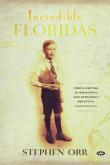AustLit
Latest Issues
AbstractHistoryArchive Description
'As Hitler's war looms, famous Australian artist Roland Griffin returns home from London with his family to live a simple life of shared plums and low-cut lawns in the suburbs.
'In the yard: a daughter, and a son, Hal, growing up with a preoccupied father who is always out in his shed stretching canvases and painting outback pubs. An isolated man obsessed with other people and places. Everything is a picture, a symbol. Even Hal, the boy in the boat, drifting through a strange world of Incredible Floridas.
'As the years pass, Roland learns that Hal is unable to control his own thoughts, impulses, behaviour. The boy becomes the destroyer of family. The neighbourhood is enlisted to help Hal find a way forward. Child actor, a clocker at Cheltenham Racecourse, an apprentice race caller. Incredible Floridas describes Hal's attempts at adulthood, love, religion, and the hardest thing of all: gaining his father's approval.' (Publication summary)
Notes
-
Epigraph: I have struck, do you realize, Incredible Floridas, where mingle with flowers the eyes of panthers in human skins! -'The Drunken Boat' Arthur Rimbaud
The earth became a dream; I myself had become an inward being, and I walked in an inward world. Everything outside me faded to obscurity, and all I had understood now was unintelligible. I fell away from the surface, down into the depths, which I recognised then to be all that was good. - The Walk Robert Walser.
Publication Details of Only Known VersionEarliest 2 Known Versions of
Other Formats
- Dyslexic edition.
- Large print.
Works about this Work
-
The Unsaid
2018
single work
essay
— Appears in: Australian Book Review , April no. 400 2018; (p. 56)'Despite the detailed excavatory art of the finest biographies, sometimes it takes the alchemical power of fiction to approximate the emotional geography of a single human and his or her milieu. Stephen Orr’s seventh novel, a compelling and at times distressing portrait of a twentieth-century Australian painter and his family, is one such book. Roland Griffin’s resemblance to that of Russell Drysdale is clear from early on, not only through Orr’s descriptions of the type of creator Griffin is – a painter of ‘small towns, deserted pubs ... it was all he knew’ – but also through the portrait of the artist’s troubled son (Drysdale’s only son suicided at the age of twenty-one). Drysdale’s family story obviously worked as a catalyst for Incredible Floridas but rather than chronicling that story itself, Orr employs his own creative divinations to construct a breathing and tactile fictional amalgam from its outlines and contours.' (Introduction)
-
The Unsaid
2018
single work
essay
— Appears in: Australian Book Review , April no. 400 2018; (p. 56)'Despite the detailed excavatory art of the finest biographies, sometimes it takes the alchemical power of fiction to approximate the emotional geography of a single human and his or her milieu. Stephen Orr’s seventh novel, a compelling and at times distressing portrait of a twentieth-century Australian painter and his family, is one such book. Roland Griffin’s resemblance to that of Russell Drysdale is clear from early on, not only through Orr’s descriptions of the type of creator Griffin is – a painter of ‘small towns, deserted pubs ... it was all he knew’ – but also through the portrait of the artist’s troubled son (Drysdale’s only son suicided at the age of twenty-one). Drysdale’s family story obviously worked as a catalyst for Incredible Floridas but rather than chronicling that story itself, Orr employs his own creative divinations to construct a breathing and tactile fictional amalgam from its outlines and contours.' (Introduction)
Awards
- 2019 longlisted International IMPAC Dublin Literary Award




